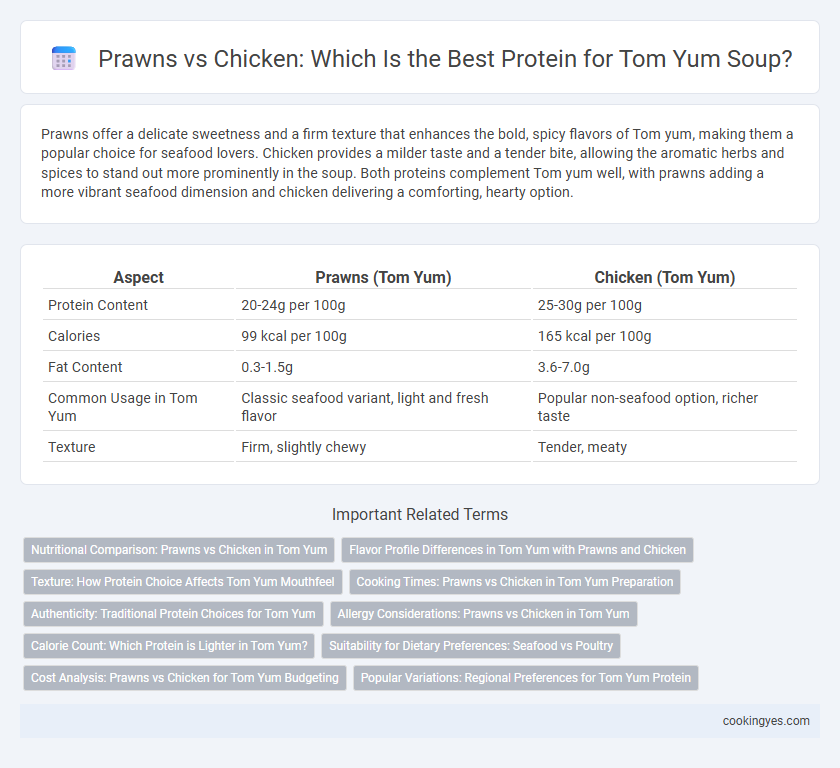Prawns offer a delicate sweetness and a firm texture that enhances the bold, spicy flavors of Tom yum, making them a popular choice for seafood lovers. Chicken provides a milder taste and a tender bite, allowing the aromatic herbs and spices to stand out more prominently in the soup. Both proteins complement Tom yum well, with prawns adding a more vibrant seafood dimension and chicken delivering a comforting, hearty option.
Table of Comparison
| Aspect | Prawns (Tom Yum) | Chicken (Tom Yum) |
|---|---|---|
| Protein Content | 20-24g per 100g | 25-30g per 100g |
| Calories | 99 kcal per 100g | 165 kcal per 100g |
| Fat Content | 0.3-1.5g | 3.6-7.0g |
| Common Usage in Tom Yum | Classic seafood variant, light and fresh flavor | Popular non-seafood option, richer taste |
| Texture | Firm, slightly chewy | Tender, meaty |
Nutritional Comparison: Prawns vs Chicken in Tom Yum
Prawns in Tom Yum provide a rich source of lean protein with high levels of omega-3 fatty acids, essential for heart and brain health. Chicken offers a higher protein content per serving and contains more vitamin B6, which supports metabolism and immune function. Both proteins are low in calories and fat, making them excellent choices for a nutritious Tom Yum, but prawns contribute more minerals like zinc and selenium.
Flavor Profile Differences in Tom Yum with Prawns and Chicken
Tom yum with prawns delivers a rich, briny flavor that enhances the soup's signature tangy and spicy notes, creating a harmonious balance between the oceanic sweetness and the broth's lemongrass and kaffir lime leaves. In contrast, chicken in tom yum provides a milder, earthier taste that allows the herbal and citrus elements to stand out more prominently without overpowering the palate. The firm texture of prawns offers a succulent bite, while chicken contributes a tender, more neutral protein that complements the soup's complex flavor dynamics.
Texture: How Protein Choice Affects Tom Yum Mouthfeel
Prawns in Tom Yum provide a firm, succulent texture that contrasts with the soup's spicy, sour broth, enhancing the overall mouthfeel with a slight snap as you bite into them. Chicken offers a softer, more tender bite that absorbs the soup's flavors deeply, creating a smoother and more uniform texture experience. The choice between prawns and chicken significantly influences the sensory perception of Tom Yum, as the textural interplay determines the dish's final mouthfeel appeal.
Cooking Times: Prawns vs Chicken in Tom Yum Preparation
Prawns cook significantly faster than chicken in Tom Yum, typically requiring only 2-3 minutes to turn opaque, ensuring they remain tender and juicy. In contrast, chicken needs approximately 15-20 minutes to cook thoroughly, which can affect the overall timing of the soup preparation. Opting for prawns allows for a quicker cooking process and preserves the delicate balance of flavors in authentic Tom Yum.
Authenticity: Traditional Protein Choices for Tom Yum
Prawns remain the quintessential protein in authentic Tom Yum, delivering a delicate sweetness and fresh ocean flavor that balances the soup's spicy and sour notes. Chicken is a popular alternative, offering a firmer texture and milder taste, but it lacks the distinct seafood profile integral to traditional recipes. Selecting prawns preserves the culinary authenticity rooted in Thai coastal cuisine, emphasizing genuine regional flavors.
Allergy Considerations: Prawns vs Chicken in Tom Yum
Prawns in Tom Yum carry a higher risk of triggering shellfish allergies, which affect approximately 2% of the global population and can cause severe reactions like anaphylaxis. Chicken is a safer alternative for those with seafood allergies, offering a high-protein option with a lower incidence of allergic reactions. Choosing chicken over prawns in Tom Yum reduces the risk of allergen exposure while maintaining the dish's rich protein content.
Calorie Count: Which Protein is Lighter in Tom Yum?
Prawns in Tom Yum contain approximately 85 calories per 100 grams, making them a lighter protein option compared to chicken, which has around 165 calories per 100 grams. Choosing prawns reduces calorie intake while still providing high-quality protein and essential nutrients. This makes prawns an ideal choice for a low-calorie Tom Yum without sacrificing flavor or nutrition.
Suitability for Dietary Preferences: Seafood vs Poultry
Prawns in Tom Yum provide a rich source of omega-3 fatty acids, ideal for those seeking heart-healthy seafood protein, while chicken offers a lean poultry option favored by individuals preferring lower fat content and a milder flavor. Seafood enthusiasts benefit from prawns' distinctive taste and nutritional profile, supporting diets rich in vitamins B12 and D. Poultry lovers find chicken a versatile choice compatible with various dietary restrictions, including lower cholesterol requirements.
Cost Analysis: Prawns vs Chicken for Tom Yum Budgeting
Prawns typically cost significantly more than chicken, impacting the overall budget for Tom Yum preparation, especially in large quantities. Chicken provides a budget-friendly protein option with a milder flavor that absorbs the soup's spices well. Cost-conscious cooks often prefer chicken to maintain authentic taste while managing expenses effectively.
Popular Variations: Regional Preferences for Tom Yum Protein
Prawns are the traditional protein choice in Tom Yum, especially favored in coastal regions of Thailand where fresh seafood is abundant and imparts a sweet, briny flavor to the spicy and sour broth. Chicken, a popular alternative, is commonly used in northern and inland areas for a milder yet hearty variation that absorbs the aromatic herbs and spices. Regional preferences highlight how prawns enhance the authentic taste, while chicken offers a versatile, protein-rich option catering to different dietary needs and availability.
Prawns vs chicken for Tom yum protein Infographic

 cookingyes.com
cookingyes.com